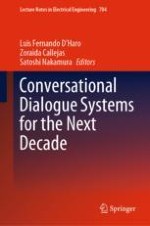2021 | OriginalPaper | Buchkapitel
Deep AM-FM: Toolkit for Automatic Dialogue Evaluation
verfasst von : Chen Zhang, Luis Fernando D’Haro, Rafael E. Banchs, Thomas Friedrichs, Haizhou Li
Erschienen in: Conversational Dialogue Systems for the Next Decade
Verlag: Springer Singapore
Aktivieren Sie unsere intelligente Suche, um passende Fachinhalte oder Patente zu finden.
Wählen Sie Textabschnitte aus um mit Künstlicher Intelligenz passenden Patente zu finden. powered by
Markieren Sie Textabschnitte, um KI-gestützt weitere passende Inhalte zu finden. powered by
